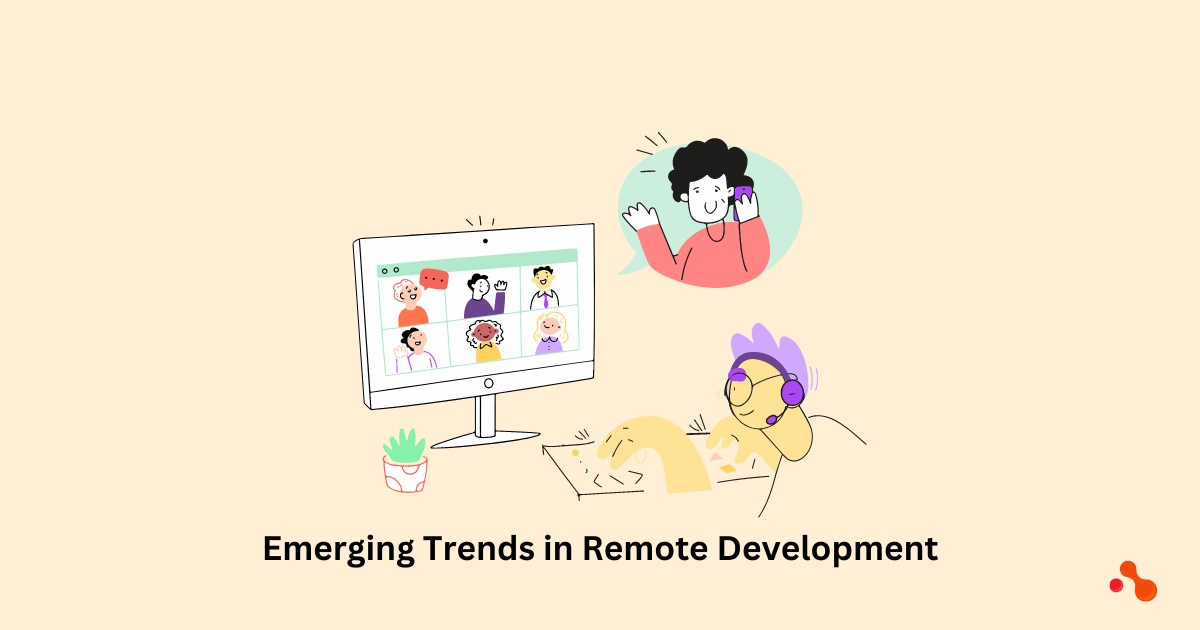Introduction
Welcome to our blog on the exciting topic of emerging trends in remote development! In this digital era, where technology continues to evolve rapidly, the way we work is also undergoing a significant transformation. Gone are the days when companies relied solely on in-house teams; now, businesses are embracing the future of distributed workforces. Imagine hiring developers from anywhere globally, bringing together diverse talent to create innovative solutions!
In this blog, we'll explore the advantages and challenges of hiring remote developers and how this trend reshapes our work. Whether you're a tech enthusiast or a curious newbie, we'll break down complex concepts and share real-world examples to make them easier to understand. So, let's dive into the fascinating world of remote development and discover how it's shaping the future of work!
The Rise of Remote Development
The way people work has been rapidly evolving, and one significant shift we've witnessed is the rise of remote work. This trend has profoundly impacted the software development industry, transforming how developers collaborate, and companies operate. Let's explore the evolution of remote work and its advantages for employees and employers, supported by statistics and real-life examples.
Advantages and Benefits of Remote Development:
- Expanded Talent Pool: Hire remote developers opens up a vast talent pool beyond geographical boundaries. Companies can now access skilled professionals worldwide, increasing their chances of finding the right fit for their projects.
- Flexibility and Work-Life Balance: Remote work allows developers to have more flexible schedules. They can choose their working hours and adapt them to their personal lives, promoting a healthier work-life balance.
- Increased Productivity: Many studies suggest remote workers are often more productive than their in-office counterparts. By eliminating long commutes and office distractions, developers can focus better, improving efficiency and output.
- Cost Savings: Remote development can significantly reduce employee and employer costs. Developers save on commuting expenses and can work from home, while companies save on office space and overhead expenses.
Statistics and Data Supporting Remote Work:
- According to a recent survey, 80% of employees believe that remote work options make them more likely to choose one job over another.
- Another study found that 65% of employees believe remote work would increase productivity.
- In a survey of 4,000 professionals, 98% responded that they would like to work remotely for the rest of their careers at least part of the time.
Case Studies of Successful Remote Development Companies:
- GitLab: GitLab is a renowned remote-first company that offers a complete DevOps platform. They have over 1,300 employees spread across 66 countries. Despite having no physical offices, they have achieved significant success, with a valuation exceeding $6 billion.
- Automattic: Automattic, the company behind WordPress.com, operates with a fully remote workforce. They have a distributed team of over 1,100 employees located in 77 countries. Their commitment to remote work has allowed them to create one of the most widely used content management systems globally.
The rise of remote development has revolutionized the software industry, offering numerous advantages for employees and employers. The flexibility, expanded talent pool, increased productivity, and cost savings make remote work appealing. Successful remote development companies like GitLab and Automattic have demonstrated the potential for achieving remarkable results without a traditional office setting. As remote work continues to gain momentum, it presents exciting opportunities for the future of software development.
Key Challenges and Solutions in Remote Development
Remote development has become increasingly common in today's digital age. While it offers numerous advantages, it also presents some challenges for both teams and individuals. Let's explore these challenges and discover effective solutions to overcome them.
- Communication and Collaboration Hurdles:
- Lack of face-to-face interaction: Remote teams may find it easier to communicate effectively with the benefits of in-person conversations. This can lead to misunderstandings and delays in project completion.
- Solution: Utilize video conferencing tools like Zoom or Microsoft Teams to conduct virtual meetings, allowing team members to see and hear each other and fostering better communication.
- Time zone differences: When team members are in different time zones, coordinating work schedules and meetings can be problematic.
- Solution: Implement time zone management tools such as World Time Buddy or Every Time Zone to schedule meetings that accommodate everyone's availability.
- Limited non-verbal cues: Remote communication often lacks non-verbal cues, such as facial expressions and body language, which can hinder understanding and effective collaboration.
- Solution: Encourage emojis and gifs in written communication to convey emotions and promote a positive and engaging atmosphere.
- Strategies and Tools to Improve Productivity:
- Project management tools: Remote teams benefit from using tools like Trello, Asana, or Jira to track tasks, assign responsibilities, and monitor progress.
- Example: Trello allows teams to create boards for different projects and cards for individual tasks, making it easy to visualize and manage workloads.
- Communication platforms: Choose reliable messaging platforms like Slack or Microsoft Teams to foster quick and efficient communication among team members.
- Example: Slack provides dedicated channels for different topics, ensuring discussions are organized and accessible to relevant team members.
- Best Practices for Effective Remote Development:
- Time management: Remote developers should establish a schedule that allows for focused work and avoids distractions.
- Example: Set specific work hours and create a dedicated workspace to maintain a structured routine and increase productivity.
- Work-life balance: Finding a healthy balance between work and personal life is important to prevent burnout and maintain overall well-being.
- Example: Take regular breaks, engage in hobbies or physical activities, and establish clear boundaries between work and personal time.
In conclusion, remote development brings its fair share of challenges, but these hurdles can be overcome with the right strategies and tools. Effective communication, project management, and personal well-being are key to successful remote development.
Emerging Trends in Remote Development
- Agile and DevOps: Imagine a soccer team working together, passing the ball swiftly, and scoring goals. Similarly, remote teams now use agile methodologies and DevOps secret tactics to coordinate and deliver faster software projects.
- Cloud and Virtual Environments: Picture a magical cloud where all your files and tools live; everyone can access them anytime, anywhere. Remote teams leverage cloud technologies and virtual environments to collaborate seamlessly, like a virtual playground for developers.
- Cross-functional and Diverse Teams: Think of a puzzle with different-shaped pieces that fit perfectly together. Remote teams are now composed of people with diverse skills, like programmers, designers, and testers, who work together to create amazing software.
- AI and Automation: Imagine having a robot helper who can do repetitive tasks, like organizing files or testing code. Remote development processes now integrate artificial intelligence and automation, making work easier and more efficient.
In a nutshell, remote development has become a supercharged game of teamwork, where agile methodologies and DevOps provide secret tactics, cloud technologies, and virtual environments offer a magical playground, diverse teams bring different skills to the table, and AI and automation act as helpful robot assistants.
Future Implications and Considerations
The software industry is experiencing significant changes due to remote development. Let's explore some anticipated changes and the long-term impact they can have:
- Anticipated changes and long-term impact of remote development on the software industry:
- Increased access to a global talent pool: Companies can hire remote developers from anywhere worldwide, allowing them to tap into diverse skills and expertise.
- Cost savings: Remote development eliminates the need for physical office spaces, reducing expenses associated with rent, utilities, and equipment.
- Improved work-life balance: Developers can work from the comfort of their homes, providing flexibility and potentially reducing stress levels.
- Collaborative tools and platforms: Remote development requires various collaboration tools and platforms, leading to advancements in remote collaboration technologies.
- Cultural and organizational adjustments required for successful remote development:
- Clear communication channels: Companies should establish effective communication channels to ensure smooth coordination among remote team members. This includes utilizing messaging apps, video conferencing, and project management tools.
- Embracing diversity and inclusion: Remote development enables integrating developers from different cultures and backgrounds, fostering a diverse and inclusive work environment.
- Trust and autonomy: Companies need to trust their remote developers and provide them with the autonomy to manage their work effectively. This promotes a sense of ownership and accountability.
- Strategies for attracting and retaining top talent in distributed workforces:
- Offering competitive compensation packages: Providing attractive salaries, benefits, and perks helps attract and retain skilled remote developers.
- Emphasizing work-life balance: Highlighting flexible working hours and policies supporting a healthy work-life balance can appeal to developers.
- Professional development opportunities: Offering opportunities for skill enhancement, such as training programs or certifications, can motivate developers to stay with the company.
- Legal and security considerations in remote development, including data protection and intellectual property:
- Data protection measures: Ensuring compliance with data protection regulations, such as encrypting sensitive information and implementing secure data transfer protocols.
- Intellectual property agreements: When working with remote developers, establish clear agreements to protect the company's rights.
- Confidentiality and non-disclosure agreements: Implementing agreements to safeguard sensitive company information and trade secrets.
Conclusion
In conclusion, the future of remote development is full of exciting possibilities and opportunities. As companies adapt to distributed workforces, remote developers are hiring. Imagine working with talented programmers from around the world without needing physical offices! Companies can tap into a global talent pool and benefit from diverse perspectives and expertise. For example, a video game company could hire developers from different countries specializing in game development, resulting in a more innovative and engaging game. So, whether you're a company looking to hire developers or a young aspiring programmer, embracing remote work opens up a world of possibilities.


No comments yet